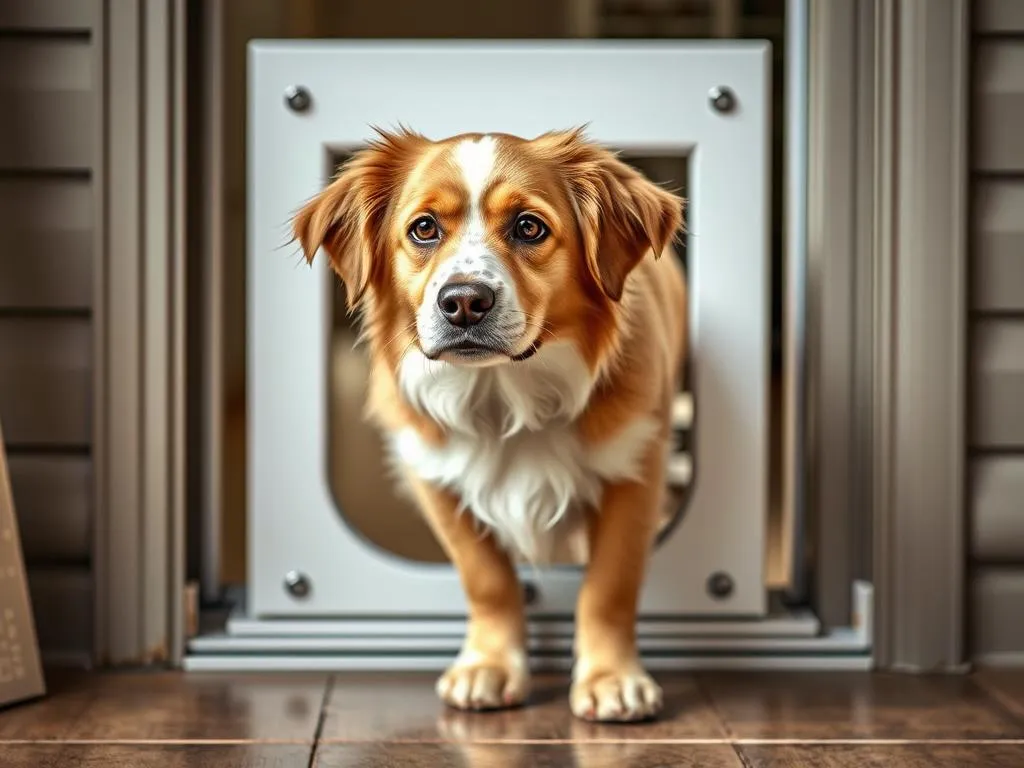
Introduction
Having a doggie door can significantly enhance your dog’s quality of life, allowing them the freedom to come and go as they please. It also provides convenience for pet owners, as it reduces the need for frequent trips outside for bathroom breaks. However, the key to maximizing these benefits lies in properly training your dog to use the door correctly. This blog post will delve into the essentials of how to train your dog to use a doggie door, covering everything from understanding doggie doors to troubleshooting common issues.
Understanding Doggie Doors
What is a Doggie Door?
A doggie door is a small opening that allows pets to enter and exit a home independently. They come in various types, including:
- Flap doors: The most common type, which features a flexible flap that pets can push open.
- Electronic doors: These are equipped with sensors that allow only specific pets to enter, providing extra security.
- Sliding doors: Designed to fit into existing sliding glass door frames.
Installing a doggie door offers numerous benefits, such as increased independence for your pet, reduced anxiety, and convenience for owners. By allowing your dog to access the outdoors freely, you can promote physical activity and improve their overall well-being.
Assessing Your Dog’s Readiness
Before initiating training, it’s crucial to assess your dog’s readiness for a doggie door. Consider the following factors:
- Size: Ensure the door is an appropriate size for your dog. A door too small can be frustrating, while one too large might be intimidating.
- Age: Puppies may need more time to adapt, while older dogs might require patience if they are not used to such openings.
- Temperament: Some dogs are naturally more curious and adventurous, while others may be hesitant or fearful.
Signs that indicate your dog is ready to learn include showing interest in the door, being comfortable with new experiences, and having basic obedience training.
Preparing for Training
Choosing the Right Doggie Door
Selecting the appropriate doggie door is critical for a successful training process. Here are some tips:
- Size: Measure your dog’s height and width to ensure the door accommodates them comfortably.
- Type: Consider your dog’s behavior. For example, an electronic door may be ideal for escape artists.
- Installation: Choose a location that is safe and convenient for your dog. Ensure that the door leads to a secure area without potential hazards.
Creating a Positive Environment
Setting up a conducive training environment is essential. Here’s how to do that:
- Comfortable Area: Make sure the space around the doggie door is inviting and familiar to your dog.
- Minimize Distractions: Limit noise and distractions during training sessions to help your dog focus.
Step-by-Step Training Process
Introducing the Doggie Door
The first step in how to train your dog to use a doggie door is to familiarize your dog with the door itself. Begin by:
- Sight and Smell: Let your dog sniff around the door, becoming accustomed to its appearance and scent.
- Sound: If the door makes noise when pushed, allow your dog to hear it without forcing them to interact.
Encouraging First Interactions
Once your dog is familiar with the doggie door, encourage them to interact with it:
- Positive Associations: Use treats and praise whenever your dog approaches or shows interest in the door.
- Pushing the Flap: Encourage them to push the flap using treats. Hold the flap open and reward them for any attempt to engage.
Gradual Training Techniques
Training should be gradual to build confidence. Follow these steps:
- Step 1: Hold the flap open and gently guide your dog through it. Use a treat to entice them to walk through.
- Step 2: If your dog is hesitant, use a leash to coax them toward the door. Gently guide them while rewarding positive behavior.
- Step 3: As your dog becomes more comfortable, reduce the assistance you provide. Allow them to push the flap independently.
Reinforcement Strategies
Reinforcement is vital for effective training:
- Consistent Rewards: Always reward your dog with treats or praise immediately after they use the door correctly.
- Timing: Ensure that rewards are given promptly to reinforce the desired behavior effectively.
Troubleshooting Common Issues
Fear or Reluctance to Use the Door
If your dog shows fear or reluctance, identify the cause:
- Noise or Movement: Determine if the sound of the flap or movement is intimidating.
- Building Confidence: Gradually expose your dog to the door’s sounds and movements while providing treats for courage.
Lack of Interest or Motivation
If your dog is uninterested in using the doggie door, consider these techniques:
- Engagement: Use their favorite toys or treats to make the area around the door more appealing.
- Playful Methods: Incorporate games that involve going in and out of the door, turning training into a fun experience.
Behavioral Problems
If negative behaviors arise, address them promptly:
- Reinforcement of Negative Behaviors: Ensure that your dog is not being rewarded for refusing to use the door or showing anxious behavior.
- Professional Help: Consider consulting a professional trainer for tailored advice if issues persist.
Maintaining the Training
Consistency is Key
Regular practice reinforces training:
- Scheduled Sessions: Incorporate short training sessions into your daily routine. Consistency helps your dog retain their training.
- Enjoyable Training: Keep sessions fun to maintain motivation and interest.
Monitoring and Adjusting
Observe your dog’s behavior over time:
- Behavioral Changes: Take note of any changes in their willingness to use the doggie door.
- Adjust Techniques: If progress stalls, be open to adjusting your training methods to better suit your dog’s needs.
Additional Tips and Considerations
Safety Precautions
Keeping your dog safe is paramount:
- Secure Installation: Ensure that the doggie door is installed securely and that there are no gaps that could pose a risk.
- Monitor Outdoor Environment: Regularly check the area outside the door for hazards, such as sharp objects or aggressive animals.
Long-Term Training Strategies
Incorporate the doggie door into daily routines:
- Encouraging Independence: Allow your dog to use the door freely as part of their daily activities.
- Supervised Freedom: Initially supervise your dog when they use the door to ensure their safety while they adapt.
Conclusion
Properly training your dog to use a doggie door can enhance both your and your pet’s life significantly. It promotes independence and convenience while offering your dog the freedom they desire. Remember to be patient, celebrate small victories, and continuously reinforce positive behavior. With the right approach, your dog will become a pro at using the doggie door in no time!









